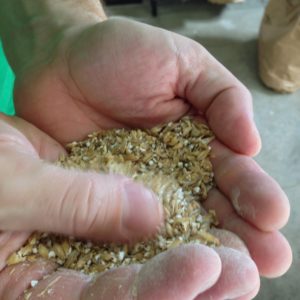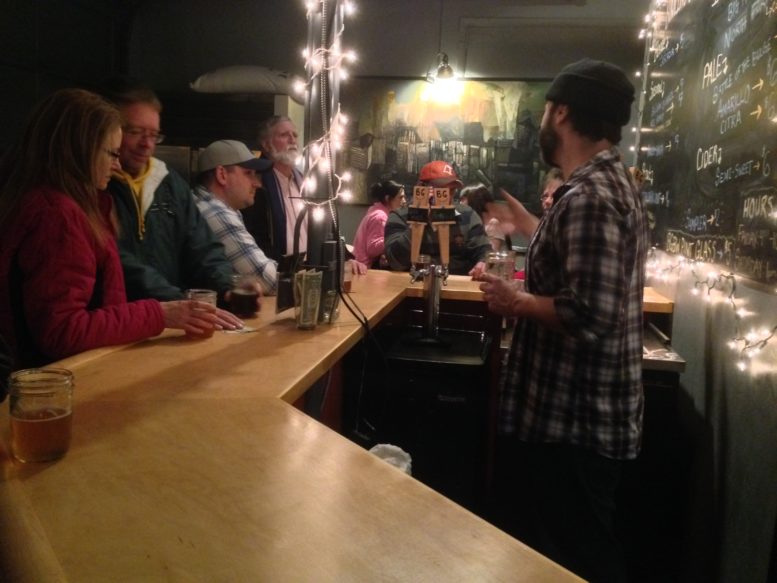By DAVID DUPONT
BG Independent News
This is the closest that Bowling Green gets to a speakeasy.
The establishment sits tucked away in a cluster of old garages at 322 North Grove St. On weekends – Friday, 4:30 to 10 p.m. and Saturday, 1 to 10 p.m., customers slip in through a back door. A newcomer can be forgiven for suspecting a secret word may be required to gain entry. Inside a couple dozen people hang out, all with pint canning jars of beer in front of them. Some of the beer is golden, some the color of caramel, others dark as chocolate. Not a “lite” beer in sight.

Justin Marx checks steeping grains at Bowling Green Beer Works.
Welcome to Bowling Green Beer Works. Here the beer is consumed within a few feet of where it is brewed. In the cooler in the corner rests the beer they’ll be sipping next week. Consumption takes its rightful place as the last step in the brewing process.
The micro brewery’s owner Justin Marx presides over the scene. He makes suggestions, describes his product, accepts comments, most of them compliments. These Friday and Saturday tastings culminate his week of work making the up to 10 varieties that he offers on any given night.
“I love my clientele,” Marx said. “We like to have a neighborhood feel. I can’t believe the tremendous amount of support we’ve gotten.”
He first applied for his permit back in September, 2014, and finally secured all his federal, state and local paperwork, so he could open the tasting room, in September, 2015.
 His love of beer making dates back further than that. Back, Marx, 42, said, to before he was legally of age to consume his product. That was in the State of Oregon, then the epicenter of the craft brewing movement.
His love of beer making dates back further than that. Back, Marx, 42, said, to before he was legally of age to consume his product. That was in the State of Oregon, then the epicenter of the craft brewing movement.
In the late 1980s, Marx said, the business model was pairing the beer with burgers. But when the market contracted in the late 1990s, the brewers shed the beef and put all the emphasis on their beer.
Craft breweries have sprung up across the nation. Ohio now has close to 150, Marx said. A 2012 change in Ohio regulations that cut the price for a tasting license from $4,000 to $1,000 also helped. He doesn’t view these other operators as rivals. Small brewers are more like a fraternity. “It’s an all-ships-rising mentality,” he said. At this point craft brewers represent 9 to 11 percent of all beer sales. “We realize the competition is about changing the palate of average Americans.”
For Marx the appeal of brewing is “you can travel around the world through different styles.” And beyond that he can concoct his own recipes. “Creating beers and beer styles is fun. We’re always tinkering around.”
 While some people used to define themselves by the brand of beer they drank, he said, now they talk about how many different brews they’ve tasted. “We try to offer something new every week.”
While some people used to define themselves by the brand of beer they drank, he said, now they talk about how many different brews they’ve tasted. “We try to offer something new every week.”
With a number of specialty grains, 100 varieties of hops and multiple types of domestic and European yeasts, he has plenty of ingredients to work with, each with its own flavor profile. As the beer moves through the process, from the initial tea in which the grains are steeped to the final fermentation, there are plenty of opportunities to tweak the flavor. Marx can decide how and when the hops are added. The choice of yeast matters. Belgian yeast delivers a beer with “banana bread” undertones. English yeast is spicy and fruity. “I tend to favor the clean American yeast,” Marx said.
He can opt to introduce CO2 to create the bubbles, or let the beer ferment longer to let the beer carbonate naturally, like champagne.
At this point, Marx produces about two barrels, or about 63 gallons, a week. That’s enough for the tasting at the brewery with some left for an outside bar, such as Myles.
That scale, though, is not sustainable. Marx would like to expand the number of bars he can service to 10 to 15 accounts. “That’s one thing I’m wrestling with… how big? People who come here don’t want this to change. I don’t want this to change.”
He may have to move up to a 10-barrel system. The limitation, though, is also the space to store all the beer that results.
Given the response, he’s gotten, Marx is optimistic about the prospects for a larger operation. Northwest Ohio’s market is still taking shape, he said. “The sky’s the limit.”




